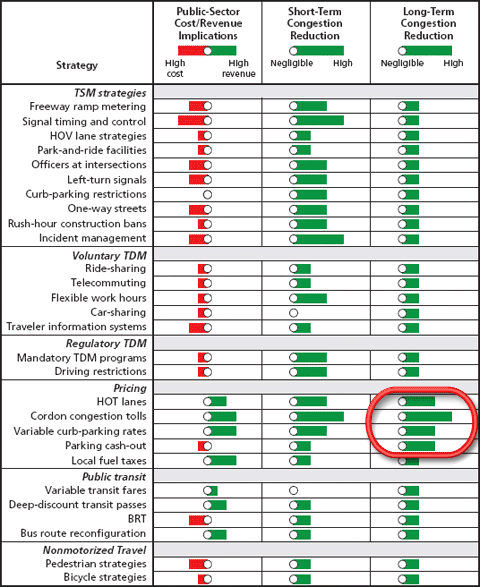Earlier this year, the RAND Corporation, a nonprofit think tank, put out a report on how to get traffic moving faster. They considered lots of the standard solutions — improving signal timing, clearing accidents quickly, encouraging telecommuting, and so forth — and found that many of them could, in fact, provide some temporary congestion relief.
But here’s the rub: RAND found that over the long haul, these kinds of solutions simply don’t have much effect on congestion. They can briefly get traffic moving faster, but just about every improvement in travel time results in … more people taking to the road! Over the long haul, apparently, most congestion relief efforts sow the seeds of their own destruction. Says RAND:
[W]hen traffic conditions on a roadway are improved during peak hours, additional travelers will tend to converge on that newly freed capacity from (1) other times of travel, (2) other routes of travel, or (3) other modes of travel, slowly eroding the initial peak-hour congestion-reduction benefits in the busiest travel corridors. Longer term increases in the demand for automotive travel resulting from population growth and economic expansion can further undermine a strategy’s effectiveness. This is why we often see, for instance, that flow improves for a short while when new lanes are added to a freeway but usually returns to former levels of congestion within just a few years.
In the end, RAND found that only a few strategies had any significant potential to curb congestion. The thing these strategies had in common was that they raised the cost of trips on congested routes. RAND singled out two basic tactics: charging tolls for driving where congestion is heaviest; and making it more expensive for drivers to park. See the chart after the jump:

That red oval highlights the only solutions that the study’s authors believe have any significant potential to fight congestion over the long term. Sadly, RAND also found that the road pricing solutions — the top two — face huge political and practical obstacles.
Which leaves parking pricing in the sweet spot. Variable parking rates and parking "cashout" (more about that) are relatively easy to implement, and have great long-term benefits for congestion. Parking cash-out — where employers give workers the option to take a cash payment in lieu of free parking — has real financial benefits as well.
But for all the other congestion-busting ideas out there — well, they might help a bit, at least for awhile. Over the long run, though, as long as we give road and parking space away for free, we’ll still be struck in traffic.

